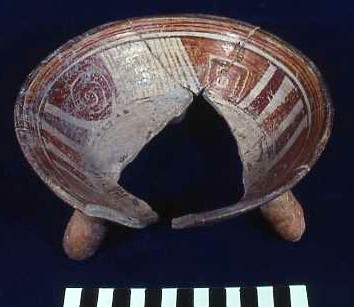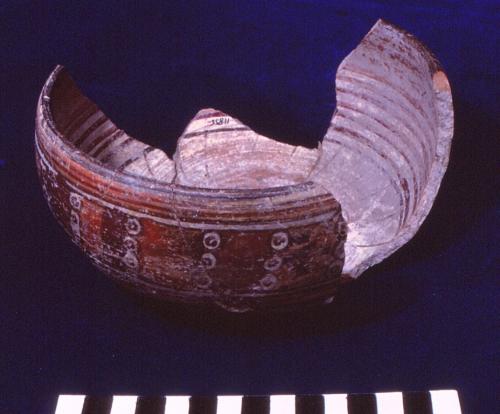Torre Red and Orange on White Polychrome
Torre Polychrome is characterized by bold red and orange painted motifs on a white background. It is one of the most distinctive types in the Cholula ceramic complex, corresponding to Noguera's Polícroma firme.
Paste and Firing Effects
The paste is a light brown to light reddish-brown color. The paste is compact and has a medium hardness. Firing anomalies are generally rare, but are most common on superhemispherical bowls which may have been heated during food preparation.
Surface Treatment
Vessel surfaces are slipped and painted, and are generally well-burnished. Decorated surfaces cover almost the entire vessel, and even the unpainted exterior base is often burnished. A characteristic of this type is the relatively good bond between the slip and vessel wall, the rationale behind Noguera's "Polícroma firme" designation.
Two subtypes (Unburnished Matte and Polished Cream) are distinguished on the basis of variant surface treatment. The Unburnished Matte subtype is distinguished by a "powdery" surface finish similar to that of Cuaxiloa Matte Polychrome. The Polished Cream subtype was highly burnished to a luster, particularly on the whitish background. Both of these subtypes were rare at UA-1, and may represent either regional variation, or perhaps idiosyncratic production.
Decoration
Painted decoration consists of red and orange painted motifs over a whitish background. The colors are bold and the application is solid, without streaks or brush strokes. Designs are usually in the form of alternating vertical bands, simple geometric motifs (especially xicalcoliuhquis), and concentric circles (Figs. 1-2). This type usually does not feature codex-style representations, with the exception of elaborately painted interior bases, especially on flared rim outleaned wall dishes.

Figure 1: Torre Polychrome conical bowl with tripod supports

Figure 2: Torre Polychrome superhemispherical bowl
Depictions on the vessel bases are often very intricate, and can resemble Codex Borgia-style representation (cf. Müller 1978:203, fig.2). Lind (1967, 1994) has illustrated a number of these with monkey (ozomaztli) heads. At UA-1, a set of four vessels were found in the Trash Midden with very similar depictions of a bald male figure with a large speech scroll coming from his mouth (Fig. 3). A fifth vessel, from the floor of Structure 1, featured an identical scene. In all five examples, and also on similar vessel bases from other collections, the image is bisected with the rear portion of the scene partially obscured by a reddish-orange wash.

A characteristic of the open vessel forms in which the major decoration occurs on the interior vessel walls is a standardized design configuration that occurs on the exterior rim. Alternating groups of red and orange diagonal lines are painted over the whitish background. This pattern also occurs on Aquiahuac Polychromes, and occasionally on Cuaxiloa Matte Polychrome.
The principal area for decoration on superhemispherical bowls was the exterior walls, although some examples also had horizontal painted lines on the interior.
Vessel Forms
Torre Polychrome is predominantly a serving ware. The most common vessel forms include outleaned wall dishes, conical bowls, superhemispherical bowls, and biconical copas. Outleaned wall dishes feature horizontally flared rims so that they are relatively shallow, measuring only about 2 to 4 cm in vessel height. They measure between 15 to 30 cm in diameter. Conical bowls have either direct or flaring rims. They measure between 15 to 25 cm in diameter, and 4 to 6 cm in vessel height. Conical bowls often have hollow, bulbous supports. Several examples have abraded interior surfaces, possibly the result of use as either spinning bowls or for whipping cacao. Superhemispherical bowls have rim diameters measuring between 15 to 20 cm, and vessel height ranges from about 7 to 10 cm.
Biconical copas are tall vessels that were probably used for consuming liquids, possibly pulque or chocolate. Copas consist of two elongated cones attached at their narrowest points to form an hourglass shape. The upper portion is finished on both the interior and exterior, while the base is only burnished on the exterior, with the interior left unfinished. The rim diameters vary between 7 and 15 cm. Vessel height is undetermined since no complete examples were found; whole pieces would probably measure between 20 and 40 cm in height.
Discussion
Torre Polychrome is one of the best known of the Cholula polychromes, but it is also one of the most problematic in terms of previous interpretations. Noguera (1954) classified it as "Polícroma firme," and suggested that it was diagnostic of the Cholulteca III period. This periodization was based on its recovery in upper levels of the ceremonial center, including the northeast platform of the Great Pyramid where the Altar of the Carved Skulls was found (Noguera 1954:226). Similar pottery was found in a large offering of vessels found at the ex-Volador (now the Supreme Court building) in Mexico City (Noguera 1954:270-271; also Solís and Morales 1991). On that basis, Noguera interpreted firme as the polychrome type that was contemporary with the Aztec empire at the time of the Conquest.
Wolfman (1968:8-9) correctly identified Polícroma firme at UA-1, in association with Structure 1. Using Noguera's ceramic sequence, he interpreted the structural compounds as dating to the Late Postclassic/ Colonial period. On the basis of the UA-1 ceramic seriation this interpretation must be revised, and in Torre Polychrome is now dated to the Late Tlachihualtepetl and Early Cholollan phases (1050 - 1400 CE). .
Torre Polychrome was also a significant component of other excavations on the UDLA campus. "Torre Multichrome" made up 4% (n=165) of the pottery from the UA-69 Faculty Housing midden deposit (Peterson 1972:200-201, Table 18). Torre Polychrome was present as 15% (n=741) of another UA-69 midden that was located just south of the UA-1 compounds (Peterson 1972:200-201, Table 18). As "Cholula Polychrome D" it appeared as 10% (n=126) and 13% (n=451), respectively, in Deposits #2 and #3 of UA-70 (Mountjoy and Peterson 1973:81, Table 8). It appeared in very low frequency (4%, n=168)) in the Late Postclassic midden (F-10) from UA-79 (Barrientos 1980). Torre Polychrome was also an important component of the midden deposit found at the Transito site (R-106) in San Pedro Cholula (McCafferty, Suárez C., and Edelstein n.d.).
The relative frequencies of Torre Polychrome in different contexts at UA-1 display a similar pattern. In the late contexts represented by Wells 1 and 2, it occurred as only a trace (.8% and 1.1%, respectively). In the Trash Midden and Well 3, however, it was more abundant (8% and 11%, respectively). It occurred as only a trace in association with Structure 1, while it made up 5% of the Structure 2 assemblage.
The UA-1 ceramic data, in combination with the other UDLA materials, indicate that Torre Polychrome was not as popular during the Late Postclassic or Colonial periods as it was earlier. It was probably near its peak popularity in the midden deposits from UA-69 and UA-70, and in the UA-1 midden and Well 3. Precise dates for these features are not available, but they probably pre-date the Faculty Housing deposit (Peterson 1972; Mountjoy and Peterson 1973:30). Torre Polychrome overlapped with Ocotlán Red Rim, particularly the Elegante subtypes, in the Late Tlachihualtepetl phase, and continued into the following Early Cholollan phase.

